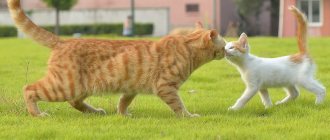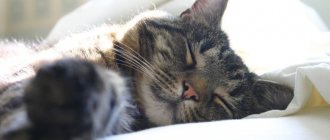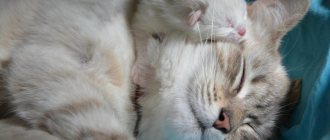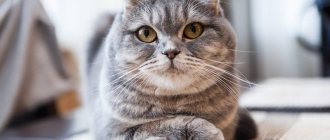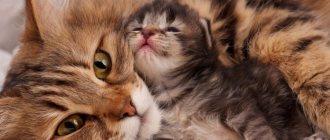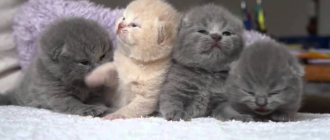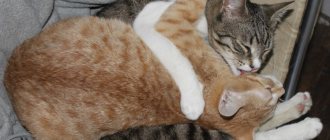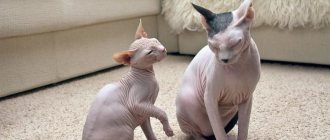Physical training
Jump
Cats are famous athletes. If nature wanted to create an ideal hunter, then it would certainly be cats. Well-built, flexible and graceful creatures, capable of real stunt tricks:
- Everyone knows about a cat's ability to land safely when falling from a height. An animal can twist in the air so as to fall on its paws and not be damaged even from a height of several floors. Curving in flight, the murka turns first its head, then its back and legs, almost at lightning speed, jumping straight to its feet. Moreover, the higher the height, the greater the chances of completing the landing successfully;
- Cats love heights. Thanks to their phenomenal sense of balance and excellent coordination, they become virtually invulnerable when climbing trees;
- The musculoskeletal system of the Murka has 250 bones and 517 muscles, and 10% of all bones are in the tail, which allows for excellent balance when running;
- Cats have fantastic vision. At a distance of sixty meters, the furry huntress is able to discern the slightest movement of the smallest rodent. Despite the fact that they don’t care about details. This explains the attempts of pets to catch a barely noticeable shadow or their own tail;
- Murki's sense of smell is 14 times greater than that of humans. And in addition to the nose, the “Jacobson’s organ” located on the palate helps the cat smell;
- A domestic cat can reach speeds of up to 48 km per hour, which exceeds the “human” record by as much as 5 km per hour;
- Murks are true hunters. Stray cats have caused the extinction of 33 animal species.
Relationships with people
Scientists believe that the domestication of cats occurred more than three thousand years ago. The Egyptians were the first to allow cats into their homes. And the ancients can be understood: the animal not only perfectly guarded food warehouses, but also rose to the rank of a deity. But it is difficult to understand a cat: it is still not clear why an independent, freedom-loving animal needed to live under the same roof with a person. Perhaps the Murkas needed universal adoration? A lot of arguments can be given in favor of this version:
- Cats have an excellent sense of intonation in the human voice. When addressing your pet harshly, remember that he will definitely feel it. But a sense of self-superiority will not allow the cat to either admit or agree with your opinion.
Murki meow only “for people.” In the company of cats, furry ones use other sounds. For unintelligent people, animals “invented” hundreds of variants of “meow”, naively believing that a person distinguishes the meaning of each of them.
- The tail serves as a kind of mood indicator. Raised vertically and slightly quivering means the cat is happy to see you. Lifelessly drooping, most likely, indicates the Murka’s reluctance to have anything to do with you. If a pet swings its tail from side to side, then it is probably deciding on something: to enter the room or not to enter, to eat or sleep. Agree, this is a matter of utmost importance.
- Cats don't always rub against humans out of friendliness. Most often, the musk smells a foreign scent on “its” person and, with the help of its scent, tries to kill someone else’s. The same explains the habit of tailed animals to sleep on clothes and new things.
- Licking belongs to the same category of gestures. If the cat begins to actively “look after” you, most likely she considers you a representative of her “herd”. And you should smell like her and generally urgently need tenderness.
- A cat tramples its owner's stomach - there is a reason for pride. The person has pleased the pet in all its whims and can calmly enjoy the neighborhood. If the cat also nudged you with its forehead, rejoice, you’ve hit a real jackpot of furry emotions.
- Cats act as a sedative. In families where furry animals live, there are fewer quarrels and significantly lower stress levels.
- Most house murkas bury traces of their vital activity. But if the animal does not try to hide its “deeds,” it tells the person: “I am not afraid of you.” This is in some way a sign of aggression or competition.
The benefits and dangers of a cat for a child
The first question parents ask before getting a kitten is the issue of safety. You can find many arguments online against cats for children. It is believed that cats are more aggressive and intolerant than dogs. However, this opinion is generated by people who do not want and do not know how to raise either themselves or their children.
A cat as an animal for children has many advantages and disadvantages:
- The cat is quite independent, so it will teach the child not only love, but also respect for animals.
- A cat requires less attention than a dog, so it is perfect as a first pet for a small child.
- From childhood, a cat will teach a child responsibility: it must be fed, the water in the bowl must be changed daily, these bowls must be washed, and traces of the cat’s pranks must be removed.
- The cat will instill in the child the skills of proper handling of animals.
- A cat helps children cope with stress more easily and without lashing out at the weaker one. Children who communicate with a cat will never become aggressive or capricious.
- A cat, oddly enough, makes the child much healthier. Scientists have proven that having a cat in the house prevents the development of asthma. If a child does not have a congenital allergy to animal fur or saliva, then this disease will bypass him if he has been in contact with a cat since childhood. In addition, children who are constantly in contact with cats develop an immune response, thanks to which they are much less likely to suffer from colds and infectious diseases.
Cats are great for dealing with stress
Remember that your cat must be vaccinated annually, wormed every three months, and treated for fleas and ticks every 2 months.
Of course, there are risks in living next to a cat:
- If a cat often walks outside, it can bring some kind of infection. Therefore, a cat for a child should only be domestic.
- Cat worms are also dangerous. However, this problem can be solved: it is enough just to give the cat anti-worm medications every three months and regularly give the child and all family members an anthelmintic.
- The cat may severely scratch or bite the child. Most often this happens not through her fault, but through the fault of the child. There are also cases when a cat has mental problems, but this is rare.
- There is such a thing as cat scratch disease, which is caused by microorganisms from under a cat's claws. When it occurs, the scratch swells and the temperature may rise slightly. In children with weak immune systems, it can lead to a mild fever. Therefore, all scratches must be quickly treated with iodine or brilliant green.
The danger of cats to children is often exaggerated
Interesting facts about cats
Mouser
- In the Middle Ages, Europe was struck by a plague epidemic. One of the reasons for the spread of the disease was the mass extermination of the cat tribe and, as a consequence, an increase in the population of rats - carriers of the plague.
- In Britain, cats guard food warehouses, for which they receive payment in the form of food, and also after a few years they go into “retirement”. One furry guard annually saves about ten tons of grain.
- Cats allow themselves to sleep for 70% of their lives.
- Among furries, there are right-handers and left-handers. The former are more common among girls, and the latter among boys.
- A cat can give birth to about a hundred kittens over the course of its life.
- The Egyptians idolized cats so much that if a pet died, they shaved off their eyebrows as a sign of mourning.
- Men who have a cat in their house are considered luckier in their personal lives.
- Excessive love for cats is quite common and has even received a name - ailurophilia.
- Cats are inferior to dogs in terms of intelligence, but are capable of performing more complex tasks. The only condition for this is the cat’s personal interest in the matter.
- Most owners (95%) admit that they talk to their pets, every fifth cat is blow-dried after bathing, and every third owner is sure that their pet reads their thoughts.
- A black cat does not always portend trouble. In Britain and Australia, such an animal is associated with great luck.
- If the cat is unsure whether it will fit through the hole, it will use its whiskers to explore the area.
- When bringing dead mice into the house, the cat does not try to feed the owner. He tries to teach him to hunt and eat properly.
- Most purrs are not that afraid of water. They can easily go into the water and fish. Home bathing frightens pets only because they are forced into a basin.
- Cats hide when they are sick. A weakened body becomes easy prey for enemies, so the animal, feeling unwell, tries to take cover
What breeds should you avoid?
Felinologists do not recommend having breeds similar to predatory cats : Chausie, Caraquet, Savannah. They have a developed wild side, so cats use their fangs and claws to protect themselves.
For example, representatives of the interracial Savannah breed are labeled F1-F7. The lower the number, the more wild blood the animal has. Such animals are suitable exclusively for aviary keeping.
The Chausie breed is also classified into 4 stages F1-F4. Cats marked F4 differ little in size from domestic cats and have the maximum level of socialization, but still are not suitable for families with children.
Fluffy record holders
The longest cat Stewie
The Guinness Book of Records also contains interesting facts about cats:
- The longest-living record holder was the cat Creme Puff from Texas. He lived for 38 years. And the oldest cat lives in Australia. She was born in 1977.
- The most famous mousetrapper was the cat Towser, who lived at the whiskey factory. During his 21 years of service, the furry hunter killed more than 28,000 rodents. A monument was erected in honor of the faithful “servant”.
- The most well-fed cat is considered to be Himmy, who weighed 21 kilograms and, thanks to a waist measuring 84 centimeters, was included in the Book of Records.
- The longest cat in the world was, of course, the Maine Coon. Its length was 123.19 cm
- The most notorious traveler is the cat Hamlet, who escaped from his carrier during a flight. Seven weeks later, the fugitive was found in the cabin. The distance that the cat “flew” was about 600 thousand km.
- The record for the largest number of cats living in one house was set in Canada. The couple Jack and Donna kept 689 pets at the same time.
- A cat named Mincho has set one of the strangest records. She climbed up a tree and didn’t get down... for six years. Living at the top, the pussy managed to give birth to kittens three times.
- A fertility record was set in Africa: a Persian cat gave birth to 14 kittens. In 1970, there was a cat in Britain who also gave birth to 19 kittens, but only 14 of them survived.
- Today, Mr Peebles is considered the smallest cat, weighing 1.35 kg with a height of just over 15 cm.
Mythical cats
Since ancient times, cats have been considered attributes of magical rituals. They were also credited with supernatural powers.
In Spanish-Jewish mythology, there is a belief that Lilith, Adam's first wife, was reincarnated as a vampire. She took the form of a black cat and drank human blood from sleeping children. Since then, there has been a superstition that cats “suck out” children's souls.
In ancient China, cats were believed to have the ability to exorcise evil spirits. These animals also personified Yin energy, femininity and darkness.
In Egyptian mythology, the sun god Ra is often represented as a red cat who swims along the underground Nile every night, fighting a serpent.
In Christianity, cats are endowed with negative traits. They are considered the embodiment of evil spirits and assistants of Satan. Beliefs say that witches flock to the Sabbath in the form of black cats.
Muslim legend says that it was a cat that saved the Prophet Muhammad from a snake attack. As a sign of gratitude, he stroked the cat, and stripes remained on its back - color. The Prophet is often called the "father of cats." There is also a legend that one day a cat fell asleep on the edge of his clothes. When leaving, he cut off the hem of his robe so as not to wake up the sleeping woman with his departure.
In Rus', cats were known back in the 7th century. Ancient legends mention the Bayun Cat, endowed with the gift of putting the enemy to sleep, thus sending death to him.
Top 20 best cat breeds for families with children
If you are choosing a kitten for a family with children, pay attention to the following qualities of the pet - they should become the fundamental selection criteria:
- stress resistance;
- lack of aggression;
- activity;
- weakly expressed territoriality;
- patience.
Let's consider the breeds that, according to the character traits considered, claim the right to become your child's furry friend.
British
Did you know that the famous Cheshire cat was a representative of the British Shorthair breed? His charming plush fur coat will not leave anyone indifferent - neither children nor adults.
In addition to the well-groomed appearance and meticulous neatness characteristic of the British, this breed is a wonderful companion. A balanced temperament helps the animal control its behavior in games, which is important when communicating with children.
The British are absolutely not aggressive, but are quite self-sufficient. Little cute animals grow into loyal and intelligent animals. By the age of three, they understand more than a hundred words and perfectly sense the mood of their owner. And of course, they have their own opinions on everything.
Keep in mind that the British are long-livers. They will grow up with your children, and later become their true friends. With good care, the British live for about 18 years.
Scottish
The Scots, especially their fold-eared representatives, evoke affection from the first minutes of meeting them. An artificially bred breed, adapted to modern living conditions in an apartment.
Kittens are easy to train, love outdoor games, and love football , which delights the kids. After noisy games, the Scotsman will be happy to watch his favorite cartoon with the baby - yes, yes, cats of this breed watch TV.
